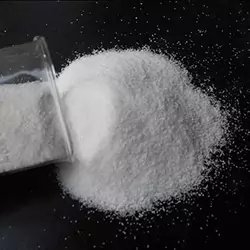IUPAC Name
Poly(2-prop-enamide)
Cas Number
9003-05-8
HS Code
3906.90.90
Formula
(C3H5NO)n
Appearance
White Powder Crystalline
Common Names
2-Propenamide Homopolymer, PAA
Packaging
20 KG/BAGS
Brief Overview
Polyacrylamide (PAM) is a water-soluble polymer made up of acrylamide subunits. It has a unique effect to increase the viscosity of water or promote the flocculation of particles present in water, it can also reduce the frictional resistance between the liquid. There are 3 different types of polyacrylamide, according to their ion characteristics, namely: non-ionic, cationic and anionic polyacrylamides. Non-ionic polyacrylamide is suitable for separating mixed organic and inorganic suspension, where the solution is neutral or acidic. Cationic polyacrylamide is suitable for suspension solutions containing organic substance and has negative charge. Anionic polyacrylamide is suitable for higher density, inorganic suspension substance with positive charge and is neutral or basic, with thick suspension particles of 1mm-10mm.
Polyacrylamide comes in various forms such as granular, liquid oil emulsion, tablet, and block forms. Dry polyacrylamide is easier to store, transport, and meter into head ditches and they also have a longer shelf life than liquid forms. However, liquid forms require less agitation to dissolve.
Manufacturing Process
Polyacrylamides are synthesized by the polymerization of acrylamide (C3H5NO). Acrylamide is usually dissolved in water, and the dissolved monomers (single-unit molecules) are induced to polymerize (link together to form large, multiple-unit molecules) through the action of free-radical initiators.
Brief Overview
Polyacrylamide (PAM) is a water-soluble polymer made up of acrylamide subunits. It has a unique effect to increase the viscosity of water or promote the flocculation of particles present in water, it can also reduce the frictional resistance between the liquid. There are 3 different types of polyacrylamide, according to their ion characteristics, namely: non-ionic, cationic and anionic polyacrylamides. Non-ionic polyacrylamide is suitable for separating mixed organic and inorganic suspension, where the solution is neutral or acidic. Cationic polyacrylamide is suitable for suspension solutions containing organic substance and has negative charge. Anionic polyacrylamide is suitable for higher density, inorganic suspension substance with positive charge and is neutral or basic, with thick suspension particles of 1mm-10mm.
Polyacrylamide comes in various forms such as granular, liquid oil emulsion, tablet, and block forms. Dry polyacrylamide is easier to store, transport, and meter into head ditches and they also have a longer shelf life than liquid forms. However, liquid forms require less agitation to dissolve.
Manufacturing Process
Polyacrylamides are synthesized by the polymerization of acrylamide (C3H5NO). Acrylamide is usually dissolved in water, and the dissolved monomers (single-unit molecules) are induced to polymerize (link together to form large, multiple-unit molecules) through the action of free-radical initiators.
